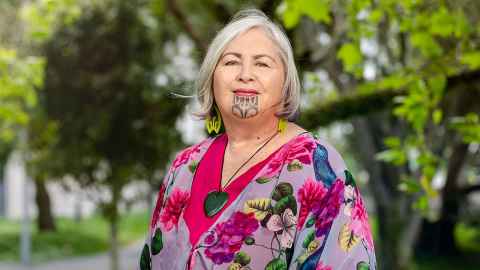Indigenous ‘living’ framework looks to help dying children live well
06 November 2025
Te Whare Kaiao is a framework adapted from the renowned Te Whare Tapa Whā model.

A new Indigenous inspired framework looks to offer hope and dignity for children with life-limiting illnesses and their whānau in Aotearoa New Zealand.
Te Whare Kaiao, supported by the whenua (land), enriched by te taiao (the natural environment) has been adapted from the renowned Te Whare Tapa Whā model by Sir Mason Durie, who also gave his approval of the ‘living’ concept.
Developed by Waipapa Taumata Rau, University of Auckland researchers Dr Gemma Aburn and Dr Tess Moeke-Maxwell, in partnership with health professionals, whānau experts, and kaumātua representatives from Te Ārai Kāhui; the framework emphasises supporting children to live fully and reach their potential.
The pair are releasing a paper on the development of Te Whare Kaiao and next week will attend the 4th International Conference on Children’s Palliative Care in Manila, to share their research.
Their vision: to move beyond the idea of palliative care as ‘end-of-life’ and instead focus on helping children with serious illness to live their lives to their full potential.
“The idea that children need palliative care is challenging for many,” says Dr Aburn. “But when we shift the focus to living well, everything changes.”
Paediatric palliative care is one of the most challenging areas of health—Te Whare Kaiao responds to this need by offering a framework that supports children to live fully and reach their potential.

Te Whare Tapa Whā has long guided Māori health with its holistic view of wellbeing—Taha wairua (spiritual), Taha tinana (physical), Taha hinengaro (mental and emotional), and Taha whānau (family and social). When clinicians began using this framework in paediatric palliative care education, it worked—but feedback from workshops revealed something was missing. Families and health professionals wanted a model that spoke directly to the unique journey of children with serious illness.
Te Whare Kaiao was born. Gifted its name by Te Ārai Kahui and developed through Kaupapa Māori research, the team worked with Auckland artist Sasha Maya to bring the framework to life. Te Whare Kaiao translates to the whare (house) that is alive, or the house of the living organism.
It’s the first framework in Aotearoa designed specifically for children’s palliative care, honouring cultural values while guiding care that is compassionate, inclusive and empowering.
“Paediatric palliative care is one of the most challenging areas of health,” says Dr Moeke-Maxwell. “Te Whare Kaiao responds to this need by offering a framework that supports children to live fully and reach their potential.”
Te Whare Kaiao
Te Whare Kaiao isn’t just theory—it’s practical. It will help clinicians deliver care that feels right for whānau, inform education and policy, and empower communities. The team also plans to create brochures so families can access the framework in everyday language.
“We want whānau to feel confident caring for their children at home, knowing what support is available,” says Dr Aburn.
But Aburn and Moeke-Maxwell need funding to make this happen—printing and distributing these resources could change lives. They welcome any offers from organisations eager to support their mahi and make a real difference to the lives of children with serious illness.
Sharing Aotearoa’s vision with the world
Aburn and Moeke-Maxwell will share Aotearoa’s vision with the world when they present Te Whare Kaiao at the conference in Manila. Their presentations will showcase how Indigenous knowledge can transform care for children everywhere.
“This is a chance to learn, share, and build partnerships that respect culture and empower families,” says Aburn.
“We’re excited to share this with the world, says Moeke-Maxwell. “But we welcome the opportunity to share this with whānau around Aotearoa, we’ll need help to do so, to ensure our young ones have the kind of support to help them live well, however long that may be.”